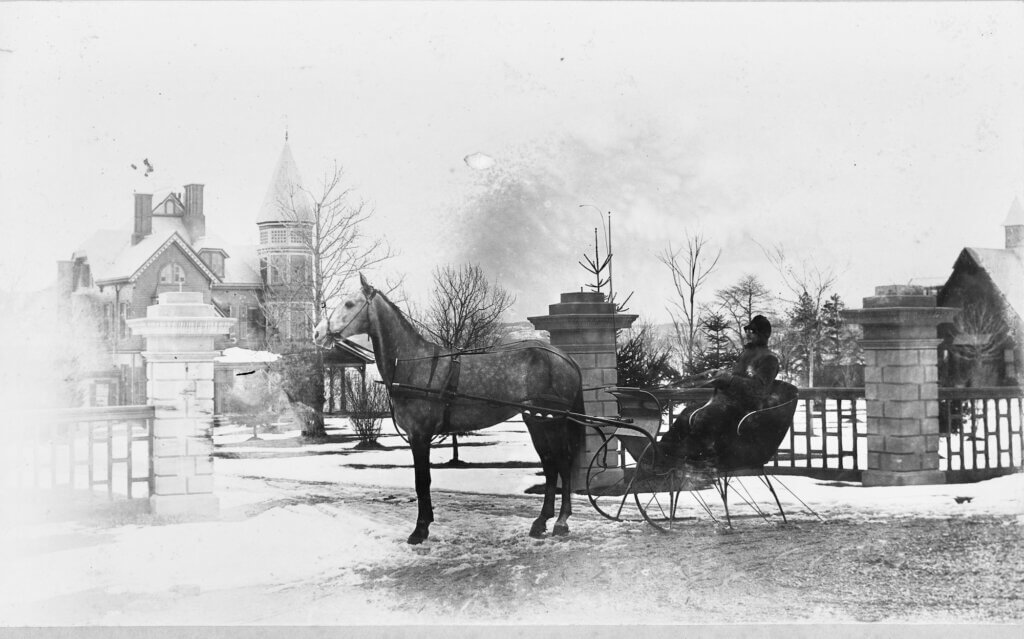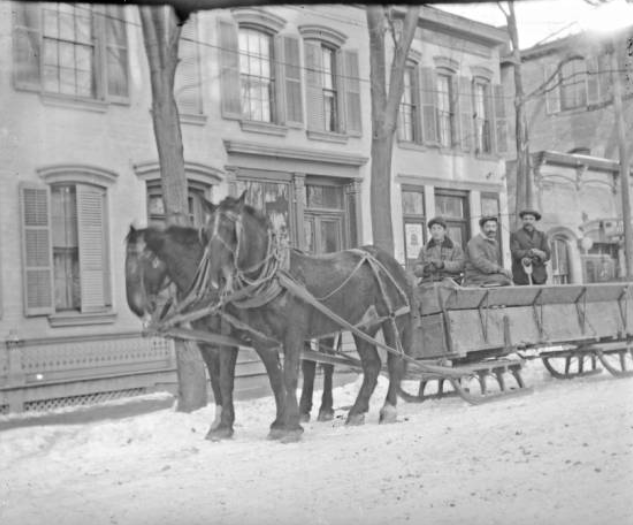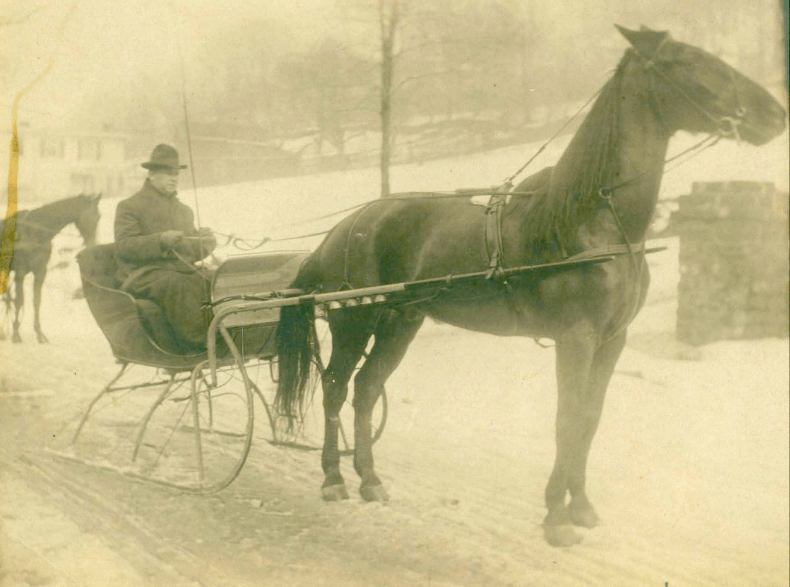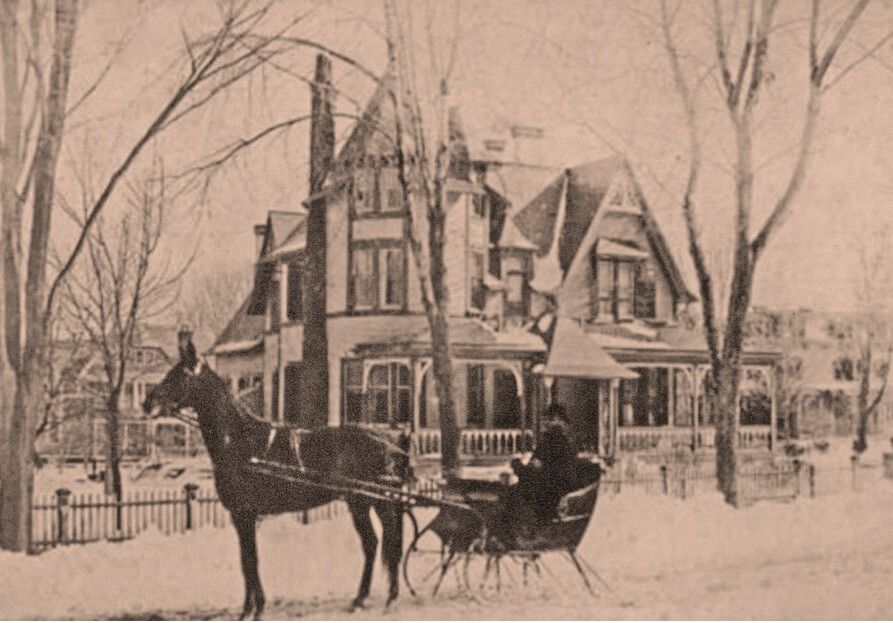Before SUVs and all-wheel drive cars, horse-drawn, locally-made sleighs navigated Nyack’s hilly unplowed roads in the winter. Nineteenth century sleighs were not like those depicted in movies and songs like “Sleigh Ride,” “Winter Wonderland,” and “Jingle Bells“. They were quite varied.
In the late-19th century, Nyack factories made shoes, pianos, and boats. Less well known, is the fact that two Nyack sleigh-makers built handmade sleighs in a wide variety of designs for a national market. Sleighs varied from one-horse open sleighs to ornate European-style sleighs accommodating eight people and a coachman.

19th Century Sleighs

Aside from having fun in the winter, sleighs served many purposes in addition to basic transportation. Businesses used toboggan-like work sleighs called “pungs” for hauling goods like baked goods, logs, and ice blocks. A favorite sport of kids at the time was “hooking pungs,” which involved catching the runners as the pung went past and going along for the ride. In New York City, large sleighs drawn by four horses served as winter commuter lines along Broadway.
In the 19th century, most roads and streets went unplowed in winter. Wheeled carriages tended to slip off icy roads. Metal sleigh runners provided better traction.

Carriage and sleigh making are similar, so many companies made both, keeping their factories busy throughout the year. Sleighs had a number of accessories, including custom paint and decals, colorful plumes, lights, and sleigh bells. Most sleigh bells were made in East Hampton, CT, once known as “BellTown.” Aside from being fashionable, bells served a useful function. They warned others of the sleigh’s approach.
The ringing of sleigh bells proved especially useful because sleighs are hard to stop and hard to turn. Accidents were not uncommon. In 1888, for example, runaway horses pulling the Niederhauser Bakery sleigh overturned as they rounded Main Street onto North Broadway and broke a glass window.

Sleigh Styles
The most popular sleigh styles were ones with a single seat board–which also happened to be the cheapest. One of these was the popular light and durable Portland Cutter. Styles evolved in the late 19th century to suit changing consumer tastes, especially for wealthier Gilded Age clients. One popular type of sleigh design that imitated carriage bodies swept the upscale market. These styles mimicked cabriolet, phaeton, and curricle carriages. A second popular style focused on Russian and German sleigh models. Upscale consumers wanted unique and custom models, and the Nyack sleigh designers met that need.

In Nyack, William Hand, owner of the Ross-Hand Mansion on Franklin Street, ordered an 8-person sleigh from the Christie Brothers. The price was $85.00.
The two Nyack sleigh factories operated for much of the 19th century. They designed and manufactured a wide variety of sleighs for local use and for national distribution. Other local Nyack companies painted, serviced, and repaired sleighs.


The Wright Factory

E.L.Wright began making carriages, wagons, harnesses, and over 27 different kinds of sleighs in 1843. Wright built his three-story wood-framed building at the corner of Hudson and Railroad Avenues (now Depot Place) near the Nyack Brook.

The Wright factory was near the Nyack train station. It was a convenient location to ship finished sleighs to distributors. The wood factory burned down in the 1880s. A new brick factory built by Wright’s son, Ornan P. Wright, opened in 1887.

O.P. Wright’s designs were often featured in Carriage Monthly, a national trade magazine. His Russian Six-Seat Vis-à-Vis sleigh body had panels on all sides that represented a shell with tiger heads carved at the doors. The bodies were painted in ultramarine blue striped with light blue. The sleighs were trimmed in blue cloth. The cushions had diamond-plaited tops with fancy buttons. And the rugs were blue with narrow red stripes bound with laces.

An article in the 1877 edition of the Rockland County Journal mentioned a visit to the shop when five pony sleighs had just been finished for a customer in Brewster, NY. They noted the superb design, painting, and trimming.
The Christie Factory

Aaron Christie was the first to make carriages and sleighs in the village, starting his business in 1835 at the corner of Liberty and Church Streets. Christie lived nearby on Broadway next to the First Presbyterian Church, now the Nyack Center. In front of the house was a town water pump, popularly known as the Christie Pump. Several shops were clustered together at the Christie factory including a harness maker, carriage trimmer, a blacksmith, wheelwright, and the painting room.

Christie’s sons, Augustus E. and James H. expanded the business in 1871 and prospered as the A.E. & J.H. Christie Company, makers of fine carriages & sleighs. Like O.P. Wright, they were a national business, advertising in the Carriage Monthly offering a fancy six-passenger Russian sleigh.

Legacy
The need for sleighs disappeared soon after the automobile appeared. The Wright factory was replaced by a box factory by 1903. Christie’s carriage works remained in business until at least 1910. It is amazing to consider that we once had tradesmen capable of such fine craftsmanship to produce amazing sleighs enjoyed in Nyack and throughout America.
Michael Hays is a 36-year resident of the Nyacks. Hays grew up the son of a professor and nurse in Champaign, Illinois. He has recently retired from a long career in educational publishing with Prentice-Hall and McGraw-Hill. He is an avid cyclist, amateur historian and photographer, gardener, and dog walker. Hays has enjoyed more years than he cares to count with his beautiful companion, Bernie Richey. You can follow him on Instagram as UpperNyackMike








